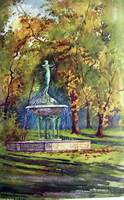It has only been possible to glance at the history and beauties of Hyde Park; many more pages could be written without touching on half of the incidents connected with it, between the days when it was monastic lands to the days of the modern Sunday "Church Parade." It is interesting to trace the origin of the little customs with which every one is now familiar, but which once were new and original.
For instance, the naming of trees and flowers in the Parks was first done about 1842, the idea having been suggested by John Claudius Loudon, and carried out by Nash the architect, and George Don the botanist.
Then the system of paying a penny for a seat began in 1820, but when some of the free seats were removed in 1859 there was a great outcry, and they were immediately put back.
Then the meets of the Four-in-hand and Coaching Clubs, which are quite an institution in Hyde Park, only continue the tradition of the "Whip Club," which first met in 1808.
The history of the various gates calls for notice. The Marble Arch, designed by Nash, with ornaments by Flaxman, Westmacott, and Rossi, in Carrara marble, was moved from Buckingham Palace to its present position in 1851. Over �4000 was expended on the removal, while the original sum spent was �75,000. The statue of George IV. by Chantrey, now in Pall Mall East, was intended for the top, and cost 9000 guineas, and the bronze gates are by Samuel Parker. Near that corner of the Park was a stone where soldiers were shot, and one of the historians of the Park states that it is still there, only covered over with earth when the new Cumberland Gate was made in 1822. Apsley Gate at Hyde Park Corner was designed by Decimus Burton, and put up in 1827, and he planned the arch forming the entrance to Constitution Hill the following year. The stags, by Bartolozzi, on Albert Gate, came from the Ranger's Lodge in Green Park. Grosvenor Gate was opened about 1724, and Stanhope Gate some twenty-five years later. All the others are more modern.
Those who wish to pursue the subject further will find such details more or less accessible in various guidebooks. But to every one the Park, with all its charms, its beauties, and its memories, is open, and it is certain that the better it is known the more it will be appreciated.

